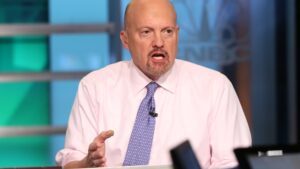Understanding Market Volatility: Insights from Jim Cramer and the Current Economic Landscape
As investors, we often find ourselves grappling with the volatility of the markets. Recently, CNBC’s Jim Cramer provided some intriguing insights into the current downturn, drawing parallels between today’s economic climate and the financial crisis in 2011. Here at Extreme Investor Network, we believe understanding these connections can empower your investment decisions. Let’s break down Cramer’s commentary and what it means for investors like you.
The "Manufactured Crisis" Explained
Cramer argues that the recent market losing streak is not just about weak earnings reports but is instead driven by larger economic issues. He refers to this situation as a "manufactured crisis," emphasizing that it is predominantly influenced by human decisions rather than fundamental economic failures.
Cramer suggests that much like the Eurozone crisis in 2011—when countries struggled under heavy debts—today’s economic anxieties are largely self-created. These include fears surrounding tariffs, political tensions, and the ever-looming debt ceiling debates. This perspective is vital for investors; recognizing that these fluctuations can be more about perception rather than reality allows you to offset your reactions accordingly.
Historical Lessons: What 2011 Can Teach Us About Today
Looking back, the downturn in 2011 was soothed when Mario Draghi, then-head of the European Central Bank, declared he would do "whatever it takes" to stabilize the economy. His promise included the buying of bonds from troubled nations, which helped restore some confidence in the markets. Cramer believes we may need a similar catalyst today.
For today’s investors, this means proactive strategies are essential. While many companies are posting solid earnings reports, as seen with many U.S. businesses, stocks continue to wobble. The takeaway? Don’t solely rely on corporate performance metrics; instead, keep an eye on broader economic indicators and political developments that could sway market perceptions.
Navigating Current Market Conditions
Cramer shines a light on the fact that unlike 2011, the current volatility is primarily a reflection of U.S.-specific issues, including:
- Trade Tariffs: Ongoing tariff disputes are causing uncertainty in sectors heavily reliant on international trade.
- Political Climate: The rhetoric surrounding key figures, such as threats to Federal Reserve Chair Jerome Powell’s position, adds a layer of concern.
- Debt Ceiling Talks: The specter of a potential debt downgrade—an event that occurred in 2011—remains a realistic fear.
Here at Extreme Investor Network, we advise investors to brace for a "down every morning" mentality, as Cramer put it. Understanding that earnings may not drive the market dynamics in the short term allows you to make more informed and strategic investment choices.
Building Your Strategy
As we navigate this uncertain landscape, consider implementing these strategies:
- Diversification: Ensure that your portfolio is not overly reliant on any single sector or asset. A diverse array of investments can help buffer against downturns in one area.
- Stay Informed: Follow economic indicators and news that could sway market sentiments. Knowledge is power, especially in volatile times.
- Long-Term Perspective: Focus on long-term goals rather than short-term fluctuations. Markets recover, and sticking to a sound investment strategy can yield benefits over time.
Conclusion
The insights shared by Jim Cramer serve as a reminder of the intricate forces at play in today’s economic environment. By understanding these connections and embracing proactive strategies, you can navigate the choppy waters of the market with confidence. At Extreme Investor Network, we are dedicated to empowering you through education and insights that matter.
Stay tuned for more valuable content and expert advice as we continue to explore the dynamic world of investing. Happy investing!

